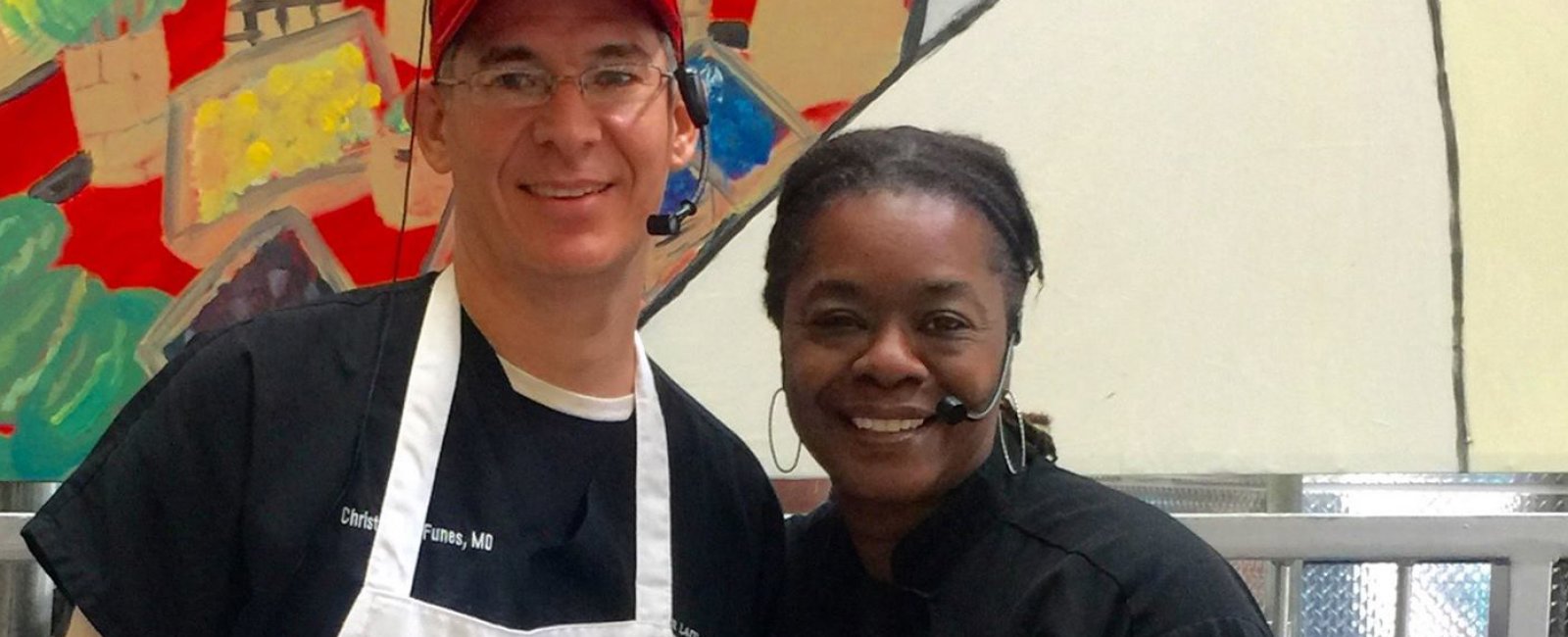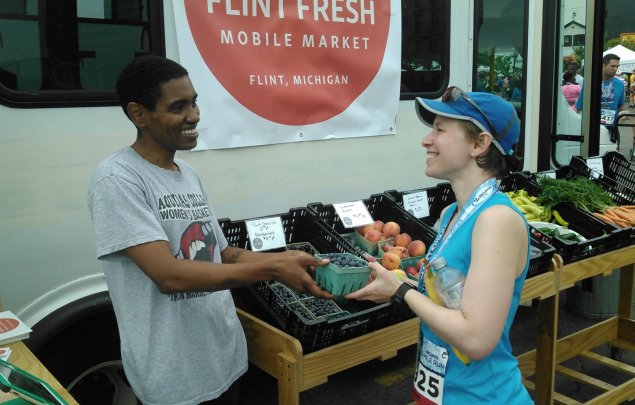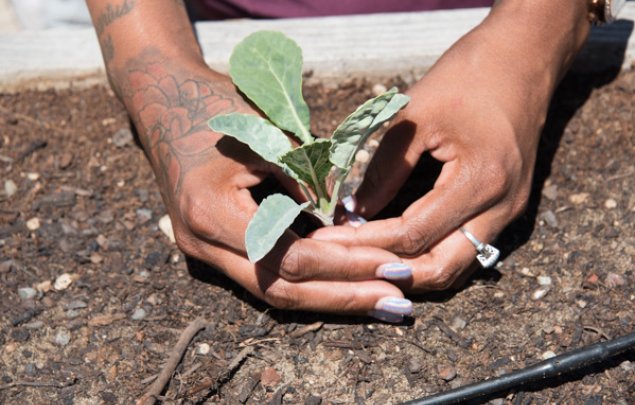City-health care partnerships to improve community health
Takeaways
- In the last ten years, diabetes has increased 37 percent in Louisiana. One in two children is obese.
- The Mayor’s Healthy City Initiative, started in 2008, directed city efforts to identify and promote collaborative solutions to improve community health. Our Lady of the Lake Regional Medical Center serves as a founding member and key supporter of the Mayor’s Healthy City Initiative.
- Our Lady of the Lake has taken an active role in supporting legislative and policy efforts that promote healthy eating and physical exercise.
- City-led efforts and the success of programs like the Red Stick Mobile Market, which receive support from OLOL community benefit, were recognized in 2014 for the Robert Wood Johnson Culture of Health Prize.
- Hospital Type Private, nonprofit, teaching hospital
- Hospital Size: Large (800 beds)
- Geographic area: Metro
- System/Network: Franciscan Missionaries of Our Lady Health System—a network of hospitals, clinics, physicians, and elderly housing
- Network coverage: Southern Louisiana (covers an 11-parish region)
- Caucasian: 47%
- African American: 45%
- Asian: 4%
- Hispanic: 4%
- Community health needs assessment region: East Baton Rouge Parish
- Population: 445,2271
- Adult obesity: 33%
- Limited access to healthy food: 11%
- Children in poverty: 28%
- Unemployment: 6%
- Food insecurity: 17%
The 2008 recession left a deep impact on the Louisiana economy that continues to be felt in East Baton Rouge Parish where Our Lady of the Lake Regional Medical Center is located. From 2009 until 2013, over 20 percent of East Baton Rouge residents lived in poverty. In the past several years, southern Louisiana has begun to experience an economic upturn that in the last year has seen the number of children living in poverty dropping by 15 percent. Still, the region lags behind the rest of the country by most social, health, and economic metrics.
The effects of a lingering recession have contributed to higher-than-average rates of food insecurity, obesity, and chronic disease rates in East Baton Rouge. Louisiana, where one in two children are obese, is 50 percent above the national rate of diabetes. These rates continue to climb and in the last ten years, the prevalence of diabetes has increased 37 percent.
In response to rising rates of obesity and diet-related health conditions, East Baton Rouge Mayor, Melvin L. “Kip” Holden, launched The Mayor’s Healthy City Initiative in 2008. The Mayor’s Healthy City Initiative (MHCI) is made up of three advisory boards that identify and promote collective and collaborative solutions to improve community health. Our Lady of the Lake has been a supporter and member of the MHCI task force since its inception.
In 2014, Baton Rouge was named a Robert Wood Johnson Foundation Culture of Health Prize Finalist in recognition of the work of the Mayor’s Healthy City Initiative. It is the MHCI, which counts over 75 multi-sector partners as members and collaborators, that has spurred and directed much of the food work happening across the region and in community benefit across the city’s five acute care hospitals.
Community health needs assessment: Priorities and process
- Food and diet-related disease priorities:
- 2015 CHNA - Obesity
- Participation from food-based organizations in community health needs assessment (CHNA) process:
- Big River Economic and Agricultural Development Association, Louisiana Center for Health Equity, Greater Baton Rouge Food Bank, Slow Food Baton Rouge, Louisiana State University Ag Center
- How/why did food issues emerge as a priority?
- High prevalence of obesity, particularly among children and adolescents, was a key factor. Strong involvement in CHNA process from food-based organizations, including Big River Economic and Agricultural Development Association (BREADA) and food banks, helped obesity emerge as one of four priority areas for the region.
- Key community indicators:
- In 2011, 36,002 cases (11.1% of the population) of diabetes were diagnosed in East Baton Rouge.
- In 2012, 4% of East Baton Rouge residents had experienced a heart attack.
- Obesity in East Baton Rouge has increased from 30% to 33% in the last three years.
Full assessment: Health Baton Rouge 2015 Community Health Need Assessment
Assessing health needs — and how to meet them
Community health needs assessment process
Our Lady of the Lake Regional Medical Center has an in-house Community Advocacy Team, headed by Coletta Barrett, Vice President of Mission for Our Lady of the Lake and Monique Marino, Director of Community Impact. The team consists of a dedicated part-time nurse, a full-time coordinator, and five PRN nurses who provide support, such as health screenings, at the OLOL mobile health unit and community health fairs.
The community benefit work of the hospital is only one of the many hats the Community Advocacy Team wears. Barrett and her team also lead a community benefit workgroup represented by approximately 20 hospital staff and administration including physicians, foundation, and ethics personnel. This workgroup provides input for the regional, collaborative CHNA the hospital participates in.
Our Lady of the Lake Regional Medical Center, along with five regional acute care hospitals, have participated in a collaborative CHNA process since 2011. In 2011-2012, the Mayor’s Healthy City Initiative facilitated a CHNA process that aligned regional hospitals’ priorities, but each hospital wrote a unique CHNA. In 2015-2016, the Mayor’s Healthy City Initiative again led a collaborative CHNA that produced a single assessment as well as a single implementation plan for all participating hospitals. During this last CHNA process, community-based organizations, including several food organizations such as Big River Economic and Agricultural Development Association (BREADA), Slow Food Baton Rouge, and Greater Baton Rouge Food Bank, provided written edits and feedback on draft assessments.
During the CHNA process, Louisiana State Public Health officials proved key to bringing food to the forefront of discussions. “During board meetings [they would] … educate board members about food insecurity, food policy, breastfeeding impacts on obesity,” said Barrett. In addition to food-related expertise, the Louisiana Public Health Department offered qualitative data, such as anecdotal and qualitative data gathered from Women, Infants and Children (WIC) Program customers, that helped further shape the background data for the CHNA.
Investing in solutions
Implementation strategy
Given the highly collaborative nature of the CHNA and the joint implementation approach of East Baton Rouge’s hospitals, Our Lady of the Lake Regional Medical Center does not approach its community benefit work alone. The regional implementation plan lists strategic objectives, action steps, resources committed by each institution, and which organizations are involved. For any given goal and its corresponding strategy, three to five hospitals commit resources and support.
For the 2015-2016 CHNA, obesity emerged as one of four community health priorities. The goal for the Healthy Baton Rouge CHNA is to “increase the number of children and adults with a healthy weight.” To accomplish this goal, the implementation plan lists four principal strategies:
- Reduce childhood obesity through health education;
- Increase access to fresh and healthy foods;
- Increase access to physical activity;
- Promote health in all policies.
An important distinction that Barrett underscores is the strategic focus on healthy eating rather than food access. “Because the priorities codified in the CHNA are healthy eating rather than food access, the framework for implementation is more narrowly focused on healthy eating … OLOL focuses their dollars on partners that can address this priority area,” she explains. Funding, then, is directed largely at organizations that focus on healthy food, such as farmer’s markets, rather than a food bank, which primarily focus on food insecurity.
This distinction is an important reminder of how the precise focus, and even wording, of implementation plan strategies can have big impacts on how hospitals direct funding and resources.
Red Stick Mobile Farmers Market
This mobile market has four weekly stops in underserved neighborhoods (including one at Our Lady of the Lake) and provides fresh fruits and vegetables to over 7,500 customers per year. The market also accepts Our Lady of the Lake-issued Veggie Rx vouchers.
- Program type: Farmers market
- Program administrator: Big River Economic and Agricultural Development Alliance (BREADA)
- Program founded: 2013
- Hospital role: Provide grant support; Conduct nutrition, food, and cooking education; Serve a managing or coordinating role in a program or community collaboration; Provide staff support for grant writing and securing sustainable funding of community benefit initiatives
- Community partners: BREADA, a community-based organization, founded and manages the program. Other regional hospital partners (Ochsner Health System and Woman’s Hospital) also host pilot sites on their campuses.
- Population served: Open to all community members
- Program goals: To increase healthy food access for patients and community residents in underserved communities
- Health needs addressed: Obesity; Increase access to fresh and healthy foods
- Key outcomes: The market provides healthy, fresh food access to 61,000 residents in low-access neighborhoods. In 2017, the Sprout Kids Club, which provides healthy eating education, signed up 374 new members.
Program description
In 1996, Big River Economic and Agricultural Development Alliance (BREADA) started the Red Stick Farmers Market with the goal of providing economic opportunities for local farmers. In 2013, BREADA added a mobile market to serve communities with low food access. Support for the program is one action step from the implementation plan that supports the obesity priority area. The directive to “create farmer’s market opportunities in low-access neighborhoods” includes a goal of growing the mobile market to five stops. The market currently operates at four locations across the parish.
The alliance purchases fresh produce from local farmers, which is then sold from the mobile market, which is managed by BREADA staff. This model allows BREADA to support local farmers, while also increasing access to communities with inadequate access to fresh, healthy foods. Our Lady the Lake (OLOL) provides incentives—a $5 token as well as a produce prescription voucher program to patients to increase purchasing power. The tokens can be used at any market site, not just those at clinic sites. The market also accepts Supplemental Nutrition Assistance Program (SNAP) and provides a SNAP match. The mobile market hosts Sprout Kids Club, a club managed by BREADA and supported by OLOL, that provides healthy eating and lifestyle education to children at the market.
Partnership and hospital role
The Red Stick Mobile Market is managed by BREADA and supported by regional hospitals in a large collaborative effort with significant resources and investments from each. Our Lady of the Lake (OLOL), for example, makes the community advocacy team available to the mobile market so nurses can offer activities, crafts, and cooking demonstrations at the market site. Woman’s Hospital staff provide onsite community education on breastfeeding and nutrition. Big River Economic and Agricultural Development Alliance also conducts outreach efforts including staffing a table at OLOL clinic sites to hand out tokens and encourage participation.
![Dr. Chris Funes, an Our Lady of the Lake pediatrician, cooking at the Red Stick Farmer’s Market with host Chef Celeste Gill. [BREADA]](/sites/default/files/styles/medium/public/inline-images/Dr.%20Funes%20photo%20-%20BREADA_0.jpg?itok=Jk35FQS-)
The relationship between OLOL and BREADA began with hospital and BREADA staff hosting cooking demonstrations and participating in community health fairs together. “We weren't interested in becoming a sponsor and just giving someone money. What we were interested in was a partnership that if we gave money, there was an impact to the community and that we'd work together on what that looked like," said Barrett. Conversations through the Healthy Baton Rouge collaborative helped this partnership develop. As a stakeholder in Healthy Baton Rouge, BREADA developed strong relationships with local hospitals that helped them align goals and work collaboratively to develop strategies to move these goals forward—strategies such as expanding the mobile market.
Financing
From 2012 to 2015, The Red Stick Mobile Market received a three-year $576,000 Challenge Grant from the Blue Cross Blue Shield Foundation of Louisiana to develop the market. This grant required a match for the $576,000 over three years— a sum that, at the time, seemed impossible to reach according to Copper Alvarez, Executive Director of BREADA. However, OLOL’s Coletta Barrett provided crucial support to BREADA in applying for and securing the challenge grant, as well as helping them raise the matching funds.
“They provided so much critical support that helped us mentally through the difficult fundraising period. They said, ‘Yes, you can do this.’ It was fabulous to have that support,”
— Copper Alvarez, Executive Director of BREADA
Our Lady of the Lake Regional Medical Center provides a $20 thousand annual grant to support the program in addition to providing staff time to assist with communications, marketing, and provide support for the Sprout Kids Club. The medical center’s chefs also provide some cooking demonstrations.
Other hospital partners also provide key support. Ochsner Health System provides 42 hours per year from their head dietician to help with nutrition education and Woman’s Hospital provides funding to support marketing and some associated permitting fees. The mobile market is also supported by fundraising for BREADA core operations, which is primarily derived from rent farmers pay for market stalls. They also receive funding from the Department of Agriculture, the Pennington Family Foundation, the Baton Rouge Area Foundation, as well as private donors.
Program evaluation and impacts
The program is currently being evaluated to determine the quantity of fresh produce sold. Market attendance is also being evaluated in order to determine optimal hours of operation and ideal site location to reach as wide a community as possible. Market hours and site locations will be adjusted based on findings. The market currently provides access to fresh food for 61,000 residents in low access communities.

Lessons learned
One lesson learned by both Barrett and Copper Alvarez was the importance of incorporating programming beyond simply the shopping experience. Healthy food education is as critical a piece as fresh food accessibility to increase healthy food consumption. For this reason, OLOL provides nurse, chef, and staff time to ensure the market has cooking demos and community education.
“Mobile markets are difficult because creating a shopping base is not as easy as taking food to food deserts. The challenge is you have to do a lot of activities around creating healthy diets,” said Alvarez. The partnership with OLOL, which provides nutrition education, is critical to changing behaviors for shoppers.
Second, Alvarez believes, is building connections between producers and shoppers. “Our farmers become loyal to shoppers and shoppers become very loyal to farmers. They share stories...It really creates a bond,” she said. This bond then helps drive shopper’s desire to return to the market and continues to build healthy eating habits, according to Alvarez.
Our Lady of the Lake also provides funding for the Sprout Kids Club, which provides age-appropriate activities for children while parents shop at the Red Stick Mobile Market. It’s these types of interactive, fun additions to the market that “make it come to life and more three-dimensional,” said Barrett.
Summer student meal program
The Department of Agriculture Summer Food Service Program provides healthy meals to children to when school is out of session. Our Lady of the Lake sponsors a feeding site at their pediatric clinic.
- Program type: Department of Agriculture Summer Food Service Program
- Program administrator: Our Lady of the Lake Regional Medical Center
- Program founded: 2015
- Hospital role: Serve a managing or coordinating role in a program or community collaboration; Provide use of hospital facilities
- Community partners: USDA Summer Food Service Program (SFSP) and Louisiana Department of Education
- Population served: Anyone under 18 years of age can receive a meal
- Program goals: To provide healthy meals to children of low-income families who might otherwise not receive consistent, nutritious meals when school is out of session.
- Health needs addressed: Healthy food access
- Key outcomes: The program served 8,994 meals since it began in 2015.
Project description
The Department of Agriculture Summer Food Service Feeding Program is a federally-funded program administered by the Department of Education at the state level. The program provides funding to community-based sponsors for summer meals for children ages 0 to 18. In 2014, Our Lady of the Lake applied to become a program sponsor, which makes the hospital eligible to receive reimbursements from USDA for meal costs. In addition to managing the meal service program, sponsors are also responsible for meeting USDA national nutritional guidelines. After a two-year pilot from 2015 through 2016, the program was extended through 2017 and is planned to continue for 2018.
The Summer Feeding Program operates May through August at the OLOL Goodwood Pediatrics Clinic site. The meals, including breakfast and lunch, are prepared at the Regional Medical Center campus and transported to the clinic. Educational materials on health, nutrition, and active lifestyles are provided with each meal.
Program participation
Every child ages 0-18 is eligible to receive meals. Per USDA regulations, every Summer Meals site must be open to the public and cannot turn any child away. The majority of children served by OLOL, however, are patients.
Partnership and hospital role
The funds for meal costs are provided by the USDA, though the grant is administered by the Department of Education and OLOL acts as program sponsor. According to the USDA, the Summer Food Service Program is severely underutilized because of challenges finding program and site sponsors with the capacity to operate the program and provide daily meal service. Our Lady of the Lake’s willingness to apply for and manage the program is an important effort to address food insecurity and healthy eating in the region.
Financing
The Department of Agriculture reimburses OLOL for the cost of meals: $2.18 for breakfast and $3.83 for lunch. The program does not cover any additional costs. Our Lady of the Lake covers the costs of staff time for meal preparation and serving, packaging, and food transportation. As a program sponsor, OLOL also invests staff time and resources in applying for sponsorship approval, attending mandatory training sessions, hiring and training staff, managing claims for reimbursement, and reporting.
Program evaluation and impacts
The program served 4,108 children in 2015, 1,925 in 2016, and 2,961 in 2017. The hospital’s pediatrics residency program also conducted an evaluation with a sample of volunteers from the pediatrics clinic. The study evaluated parents and their child’s anxiety as related to food insecurity. The study found that children exhibit much higher awareness of their household’s food insecurity than parents estimate and that children experience high degrees of anxiety over food insecurity.
Lessons learned
Launching a new Summer Meals site presented a big learning opportunity— and significant challenges— for OLOL. The primary challenge was the heavy regulation that made it difficult for staff to implement and manage the program while adhering to USDA’s many requirements and restrictions. The program, for example, requires that children eat their meals on site. Due to food safety concerns, children are not allowed to leave with any food. This is difficult for busy moms who need to return to work or get children to school. Working within the strict nutrition guidelines while staying on budget also proved difficult. Meeting dietary guidelines while also making fresh, tasty, and kid-friendly food was challenging given the small per-meal allowance set by USDA. While OLOL is reimbursed for the cost of meals, the hospital is careful not to lose money on making meals.
The biggest challenge for the program, however, is the age limitation. The program is strict about serving only children under 18. It can be difficult to turn someone away who doesn’t meet the age requirement. “Sometimes we see that mom is also hungry, but we can only hand bags to those under 18,” said Monique Marino, Director of Community Impact for Our Lady of the Lake. Despite the barriers, the OLOL staff is dedicated to the program and believes in the impact it has in reducing food insecurity. The hospital decided to continue the program past its two-year pilot and has no plans to discontinue its support and sponsorship of the site. Quite simply, said Marino, “It’s the right thing to do.”
Central Area Transit Grocery Express
Our Lady of the Lake provided support for the development of a “Grocery Express” bus line for the Baton Rouge Central Area Transit to increase access to grocery stores for neighborhoods in food deserts.
- Program type: Policy support
- Program administrator: Sustainable Transportation Advisory Committee (STAC) of Healthy Baton Rouge
- Year founded: 2015
- Hospital role: Participate in policy advocacy
- Community partners: Sustainable Transportation Advisory Committee (STAC) of Healthy Baton Rouge
- Program goals: Increase food access for low-access communities
- Health needs addressed: Obesity
- Key outcomes: Bus line not yet implemented, but a study has been commissioned to examine bus patterns.
Project description
One of the objectives to address the obesity priority area in the 2016 Healthy Baton Rouge Implementation Plan is to implement the recommendations of the Food Access Policy Commission. In 2014, one of the commission’s five recommendations for increasing food access was to create a “grocery express” bus line to connect neighborhoods in food deserts to grocery stores. Our Lady of the Lake Regional Medical Center provided support for the initiative by sharing data with the local transit department and advocating for the bus line expansion project. The route was created internally by the transit system, but not implemented due to a lack of funding. Central Area Transit and the Sustainable Transportation Advisory Committee are currently working with Healthy Baton Rouge to secure funding for the bus line.
Partnership and hospital role
Our Lady of the Lake provided data to East Baton Rouge Central Area Transit for a study to evaluate bus lines and connectivity of residents to grocery stores.
Evaluation
There have been some bus pattern changes, but a dedicated grocery express bus line has not yet developed. There are no evaluations for this project.
As a community, East Baton Rouge Parish has made significant investments to address high obesity rates and food insecurity. Although much of the effort was driven at a high-level by the city government, the Mayor’s Healthy City Initiative has successfully leveraged community strengths to develop fruitful partnerships. For any given community needs priority, investments by Our Lady of the Lake are made collectively and collaboratively together with partners and other regional hospitals so that no single institution faces these heavy lifts alone.









